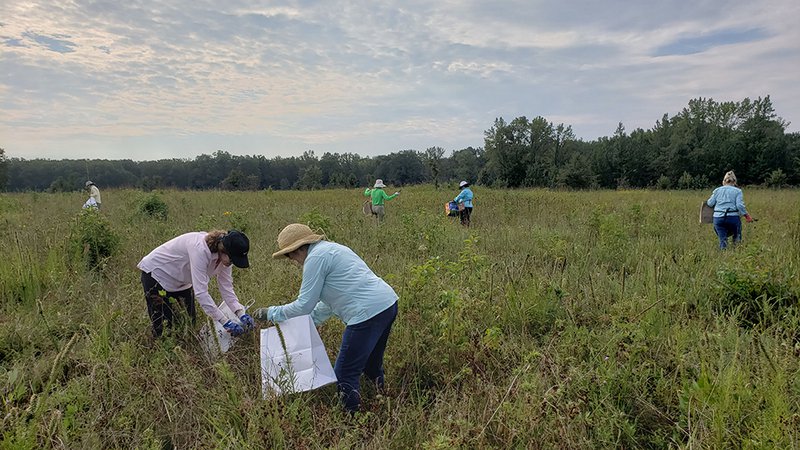Garden club offers missing piece to prairie restoration
ON 04-07-2021

April 7, 2021
Randy Zellers
Assistant Chief of Communications
LITTLE ROCK — An innovative partnership between the Arkansas Game and Fish Commission and the Little Rock Garden Club has literally planted the seeds of conservation near central Arkansas’s largest water-supply reservoir.
The Covey is a Partners for Plants project developed by LRGC that combines the efforts of many state agencies and nonprofit organizations to restore native prairie plants and pollinator species on 12 acres of land belonging to Central Arkansas Water. The property once was used as a sod farm, but with the garden club’s help, it soon will become a section of prairie that benefits species such as northern bobwhite and pollinators like monarch butterflies.

Libby Davis is a member of the garden club who, along with Helen Moix, headed up the project. She said the endeavor has offered many garden club members a chance to participate in conservation efforts with the skills and passion they have for plants.
“We reached out to The Nature Conservancy to see if there were some partnership opportunities to team up with someone for conservation efforts, and that led us to the Arkansas Game and Fish Commission,” Davis said. “Scott Simon at TNC told us about the AGFC’s quail restoration efforts, so we talked to (AGFC deputy director) Chris Colclasure, who put us in touch with Allison Fowler. From there the project really took off.”
Fowler is the Wildlife Diversity Program coordinator for the AGFC. She has worked for many years building relationships with other agencies to benefit many game and nongame species in The Natural State.
“We work with many different nonprofit groups and organizations to stretch our money as far as possible and accomplish our goals, so when the garden club reached out to us in 2018, we had the perfect opportunity for them,” Fowler said. “Garden club members could help gather and plant seeds from native, local genotypes on the old Zoysia farm now owned by Central Arkansas Water to rebuild that lost prairie ecosystem.”
The project was awarded a $6,000 grant from The Garden Club of America through its Partners for Plants program. The funds could be used during the next three years to help LRGC carry out its restoration efforts.
Garden club members then joined with members of Audubon Arkansas, Central Arkansas Water, The Nature Conservancy, Arkansas Natural Heritage Commission and Quail Forever to gather seeds from local sources.
“We would go out once a month for six months of each year to Mayflower and other areas near the restoration site to gather seeds from wild plants,” Davis said. “Theo Witsell at the Natural Heritage Commission, Allie at AGFC, Jonathan Young from Audubon Arkansas, and Ryan Diener at Quail Forever helped us with identifying which plants we needed. They were all really great with showing us how to gather and dry the seeds.”

Once seeds were collected, they were dried and cleaned at Audubon Arkansas to prepare them for planting.
“The entire experience was so different than what most of our members get to experience,” Davis said. “And when we were finished, we were told that the seed we had collected would have cost about $7,000 to purchase, so it was really encouraging knowing that our efforts were really making a difference.”
After two years of collections, the Covey had enough seed to begin the planting process on the old sod farm. Central Arkansas Water conducted prescribed burns on the property in January to clear out competing vegetation and promote any native plant seeds available. Volunteers then spent a day sowing their native seed into the prepared soil.
“We broadcast seeded the area with a hopper and by hand in February,” Davis said. “We were able to get in right before the huge snowstorm that hit Arkansas, and there was still ice on the ground from the other storm that hit a few days earlier.”
When the planting was done, the team had managed to seed 90 percent of the project site with native plants.
“We plan to keep going and collect more seed to finish it up this year,” Davis said. “We’ll start gathering again in June when native plants begin to produce seeds. We want to keep this project going even after the initial location is complete.”

Recent News

Arkansas Wildlife Weekly Fishing Report
Jul. 25, 2024
Subscribe to Our Weekly Newsletter E-mails
Don’t miss another issue. Sign up now to receive the AGFC Wildlife Weekly Newsletter in your mailbox every Wednesday afternoon (Waterfowl Reports are published weekly during waterfowl season and periodically outside the season). Fishing Reports arrive on Thursdays. Fill in the following fields and hit submit. Thanks, and welcome!

